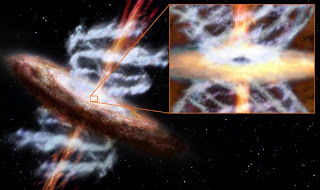
A curious correlation between the mass of a galaxy's central black hole and the velocity of stars in a vast, roughly spherical structure known as its bulge has puzzled astronomers for years. An international team led by Francesco Tombesi at NASA's Goddard Space Flight Center in Greenbelt, Md., now has identified a new type of black-hole-driven outflow that appears to be both powerful enough and common enough to explain this link.
Most big galaxies contain a central black hole weighing millions of times the sun's mass, but galaxies hosting more massive black holes also possess bulges that contain, on average, faster-moving stars. This link suggested some sort of feedback mechanism between a galaxy's black hole and its star-formation processes. Yet there was no adequate explanation for how a monster black hole's activity, which strongly affects a region several times larger than our solar system, could influence a galaxy's bulge, which encompasses regions roughly a million times larger.
"This was a real conundrum. Everything was pointing to supermassive black holes as somehow driving this connection, but only now are we beginning to understand how they do it," Tombesi said.
Active black holes acquire their power by gradually accreting or "feeding" on million-degree gas stored in a vast surrounding disk. This hot disk lies within a corona of energetic particles, and while both are strong X-ray sources, this emission cannot account for galaxy-wide properties. Near the inner edge of the disk, a fraction of the matter orbiting a black hole often is redirected into an outward particle jet. Although these jets can hurl matter at half the speed of light, computer simulations show that they remain narrow and deposit most of their energy far beyond the galaxy's star-forming regions.
Most big galaxies contain a central black hole weighing millions of times the sun's mass, but galaxies hosting more massive black holes also possess bulges that contain, on average, faster-moving stars. This link suggested some sort of feedback mechanism between a galaxy's black hole and its star-formation processes. Yet there was no adequate explanation for how a monster black hole's activity, which strongly affects a region several times larger than our solar system, could influence a galaxy's bulge, which encompasses regions roughly a million times larger.
"This was a real conundrum. Everything was pointing to supermassive black holes as somehow driving this connection, but only now are we beginning to understand how they do it," Tombesi said.
Active black holes acquire their power by gradually accreting or "feeding" on million-degree gas stored in a vast surrounding disk. This hot disk lies within a corona of energetic particles, and while both are strong X-ray sources, this emission cannot account for galaxy-wide properties. Near the inner edge of the disk, a fraction of the matter orbiting a black hole often is redirected into an outward particle jet. Although these jets can hurl matter at half the speed of light, computer simulations show that they remain narrow and deposit most of their energy far beyond the galaxy's star-forming regions.

No comments:
Post a Comment